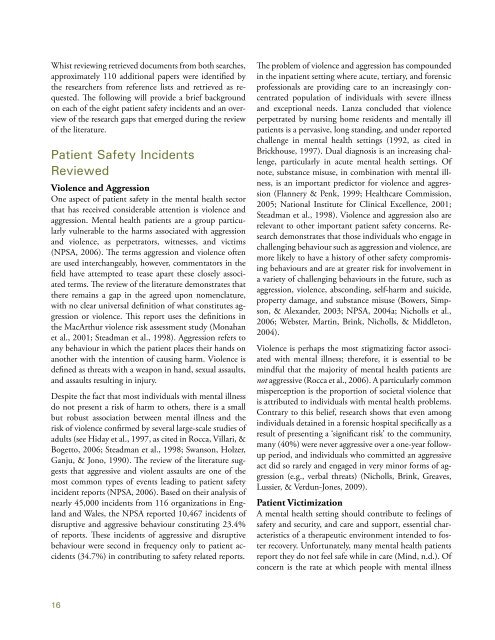Patient safety in mental health - Canadian Patient Safety Institute ...
Patient safety in mental health - Canadian Patient Safety Institute ...
Patient safety in mental health - Canadian Patient Safety Institute ...
Create successful ePaper yourself
Turn your PDF publications into a flip-book with our unique Google optimized e-Paper software.
Whist review<strong>in</strong>g retrieved documents from both searches,<br />
approximately 110 additional papers were identified by<br />
the researchers from reference lists and retrieved as requested.<br />
The follow<strong>in</strong>g will provide a brief background<br />
on each of the eight patient <strong>safety</strong> <strong>in</strong>cidents and an overview<br />
of the research gaps that emerged dur<strong>in</strong>g the review<br />
of the literature.<br />
<strong>Patient</strong> <strong>Safety</strong> Incidents<br />
Reviewed<br />
Violence and Aggression<br />
One aspect of patient <strong>safety</strong> <strong>in</strong> the <strong>mental</strong> <strong>health</strong> sector<br />
that has received considerable attention is violence and<br />
aggression. Mental <strong>health</strong> patients are a group particularly<br />
vulnerable to the harms associated with aggression<br />
and violence, as perpetrators, witnesses, and victims<br />
(NPSA, 2006). The terms aggression and violence often<br />
are used <strong>in</strong>terchangeably, however, commentators <strong>in</strong> the<br />
field have attempted to tease apart these closely associated<br />
terms. The review of the literature demonstrates that<br />
there rema<strong>in</strong>s a gap <strong>in</strong> the agreed upon nomenclature,<br />
with no clear universal def<strong>in</strong>ition of what constitutes aggression<br />
or violence. This report uses the def<strong>in</strong>itions <strong>in</strong><br />
the MacArthur violence risk assessment study (Monahan<br />
et al., 2001; Steadman et al., 1998). Aggression refers to<br />
any behaviour <strong>in</strong> which the patient places their hands on<br />
another with the <strong>in</strong>tention of caus<strong>in</strong>g harm. Violence is<br />
def<strong>in</strong>ed as threats with a weapon <strong>in</strong> hand, sexual assaults,<br />
and assaults result<strong>in</strong>g <strong>in</strong> <strong>in</strong>jury.<br />
Despite the fact that most <strong>in</strong>dividuals with <strong>mental</strong> illness<br />
do not present a risk of harm to others, there is a small<br />
but robust association between <strong>mental</strong> illness and the<br />
risk of violence confirmed by several large-scale studies of<br />
adults (see Hiday et al., 1997, as cited <strong>in</strong> Rocca, Villari, &<br />
Bogetto, 2006; Steadman et al., 1998; Swanson, Holzer,<br />
Ganju, & Jono, 1990). The review of the literature suggests<br />
that aggressive and violent assaults are one of the<br />
most common types of events lead<strong>in</strong>g to patient <strong>safety</strong><br />
<strong>in</strong>cident reports (NPSA, 2006). Based on their analysis of<br />
nearly 45,000 <strong>in</strong>cidents from 116 organizations <strong>in</strong> England<br />
and Wales, the NPSA reported 10,467 <strong>in</strong>cidents of<br />
disruptive and aggressive behaviour constitut<strong>in</strong>g 23.4%<br />
of reports. These <strong>in</strong>cidents of aggressive and disruptive<br />
behaviour were second <strong>in</strong> frequency only to patient accidents<br />
(34.7%) <strong>in</strong> contribut<strong>in</strong>g to <strong>safety</strong> related reports.<br />
1<br />
The problem of violence and aggression has compounded<br />
<strong>in</strong> the <strong>in</strong>patient sett<strong>in</strong>g where acute, tertiary, and forensic<br />
professionals are provid<strong>in</strong>g care to an <strong>in</strong>creas<strong>in</strong>gly concentrated<br />
population of <strong>in</strong>dividuals with severe illness<br />
and exceptional needs. Lanza concluded that violence<br />
perpetrated by nurs<strong>in</strong>g home residents and <strong>mental</strong>ly ill<br />
patients is a pervasive, long stand<strong>in</strong>g, and under reported<br />
challenge <strong>in</strong> <strong>mental</strong> <strong>health</strong> sett<strong>in</strong>gs (1992, as cited <strong>in</strong><br />
Brickhouse, 1997). Dual diagnosis is an <strong>in</strong>creas<strong>in</strong>g challenge,<br />
particularly <strong>in</strong> acute <strong>mental</strong> <strong>health</strong> sett<strong>in</strong>gs. Of<br />
note, substance misuse, <strong>in</strong> comb<strong>in</strong>ation with <strong>mental</strong> illness,<br />
is an important predictor for violence and aggression<br />
(Flannery & Penk, 1999; Healthcare Commission,<br />
2005; National <strong>Institute</strong> for Cl<strong>in</strong>ical Excellence, 2001;<br />
Steadman et al., 1998). Violence and aggression also are<br />
relevant to other important patient <strong>safety</strong> concerns. Research<br />
demonstrates that those <strong>in</strong>dividuals who engage <strong>in</strong><br />
challeng<strong>in</strong>g behaviour such as aggression and violence, are<br />
more likely to have a history of other <strong>safety</strong> compromis<strong>in</strong>g<br />
behaviours and are at greater risk for <strong>in</strong>volvement <strong>in</strong><br />
a variety of challeng<strong>in</strong>g behaviours <strong>in</strong> the future, such as<br />
aggression, violence, abscond<strong>in</strong>g, self-harm and suicide,<br />
property damage, and substance misuse (Bowers, Simpson,<br />
& Alexander, 2003; NPSA, 2004a; Nicholls et al.,<br />
2006; Webster, Mart<strong>in</strong>, Br<strong>in</strong>k, Nicholls, & Middleton,<br />
2004).<br />
Violence is perhaps the most stigmatiz<strong>in</strong>g factor associated<br />
with <strong>mental</strong> illness; therefore, it is essential to be<br />
m<strong>in</strong>dful that the majority of <strong>mental</strong> <strong>health</strong> patients are<br />
not aggressive (Rocca et al., 2006). A particularly common<br />
misperception is the proportion of societal violence that<br />
is attributed to <strong>in</strong>dividuals with <strong>mental</strong> <strong>health</strong> problems.<br />
Contrary to this belief, research shows that even among<br />
<strong>in</strong>dividuals deta<strong>in</strong>ed <strong>in</strong> a forensic hospital specifically as a<br />
result of present<strong>in</strong>g a ‘significant risk’ to the community,<br />
many (40%) were never aggressive over a one-year followup<br />
period, and <strong>in</strong>dividuals who committed an aggressive<br />
act did so rarely and engaged <strong>in</strong> very m<strong>in</strong>or forms of aggression<br />
(e.g., verbal threats) (Nicholls, Br<strong>in</strong>k, Greaves,<br />
Lussier, & Verdun-Jones, 2009).<br />
<strong>Patient</strong> Victimization<br />
A <strong>mental</strong> <strong>health</strong> sett<strong>in</strong>g should contribute to feel<strong>in</strong>gs of<br />
<strong>safety</strong> and security, and care and support, essential characteristics<br />
of a therapeutic environment <strong>in</strong>tended to foster<br />
recovery. Unfortunately, many <strong>mental</strong> <strong>health</strong> patients<br />
report they do not feel safe while <strong>in</strong> care (M<strong>in</strong>d, n.d.). Of<br />
concern is the rate at which people with <strong>mental</strong> illness


